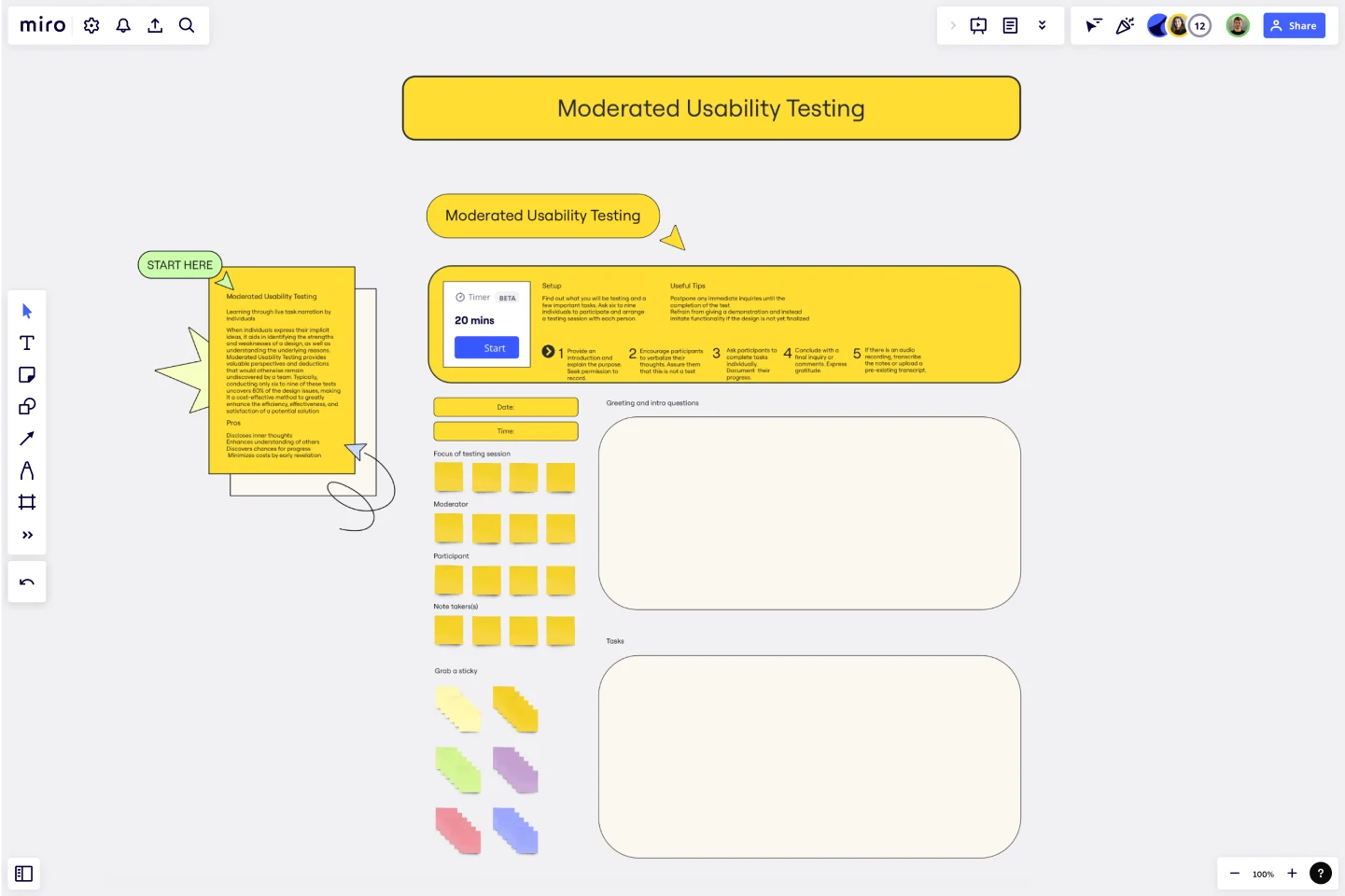Moderated Usability Testing Template
Learn through live task narration with the Moderated Usability Testing Template.
About Moderated Usability Testing Template
The Moderated Usability Testing Template helps you guide people to express their implicit ideas about a design, providing valuable insights into its strengths and weaknesses and the underlying reasons for them.
This method allows a team to gain a deeper understanding of potential issues and to identify areas where improvements can be made. By conducting only six to nine of these tests, a team can uncover as much as 80% of the design issues, making it a highly efficient and cost-effective approach for enhancing a potential solution's overall efficiency, effectiveness, and satisfaction.
Benefits of using the template
Disclose inner thoughts.
Enhance understanding of others.
Discover chances for progress.
Minimize costs by early revelation.
How to use the template in Miro
Provide an introduction and explain the purpose. Seek permission to record.
Encourage participants to verbalize their thoughts. Assure them that this is not a test.
Ask participants to complete tasks individually. Document their progress.
Conclude with a final inquiry or comments. Express gratitude.
If there is an audio recording, transcribe the notes or upload a pre-existing transcript.
Setup
Find out what you will be testing and a few important tasks.
Ask six to nine people to participate and arrange a testing session with each person.
Useful tips
Postpone any immediate inquiries until the completion of the test.
Refrain from giving a demonstration and instead imitate functionality if the design is not yet finalized.
Get started with this template right now.
Basic Storyboard Template
Works best for:
Storyboard
The Basic Storyboard template helps visualize and plan creative projects by breaking down scenes into manageable parts. With spaces for visuals, dialogue, audio, and notes, it ensures clarity and organization. Perfect for teams in film, animation, or presentations, this template enhances communication and saves time by providing a structured format to plan, review, and refine your project’s narrative and flow.
Tell a Great Story
Works best for:
Storyboard
Tell a great story with the Storyboard template. Visualize your narrative using images, notes, and descriptions to map out each scene. This template is perfect for filmmakers, content creators, and marketers looking to craft compelling stories. It helps you organize your thoughts, sequence your story elements, and ensure a cohesive flow. Whether you're planning a video, a marketing campaign, or a presentation, this tool makes storytelling easier and more effective.
Empathy Map by Back of the Napkin Consulting
Works best for:
Research & Design, Market Research
The Empathy Map template is designed to help you understand your users deeply. It captures user behaviors, thoughts, and feelings, allowing you to design products that truly resonate with their needs. Use this template to enhance your UX research and create user-centered designs.
Vision Storyboard Or Narrative
Works best for:
Storyboard, Planning, Design
Craft compelling narratives with the Vision Storyboard or Narrative template. This versatile tool is perfect for developing vision statements, strategic narratives, or creative stories. It helps you outline key elements, plot progression, and visual themes, ensuring a coherent and impactful story. Use this template to align your team on the narrative vision and create a compelling storyline that resonates with your audience and stakeholders.
Job Map Template
Works best for:
Design, Desk Research, Mapping
Want to truly understand your consumers’ mindset? Take a look at things from their perspective — by identifying the “jobs” they need to accomplish and exploring what would make them “hire” or “fire” a product or service like yours. Ideal for UX researchers, job mapping is a staged process that gives you that POV by breaking the “jobs” down step by step, so you can ultimately offer something unique, useful, and different from your competitors. This template makes it easy to create a detailed, comprehensive job map.
Empathy Map [Research]
Works best for:
Market Research, Research & Design
Empathy Map Research template helps you gather in-depth user insights. It’s designed for teams who want to understand user behaviors and needs better. Use this template to inform your design decisions and create user-centered products.
